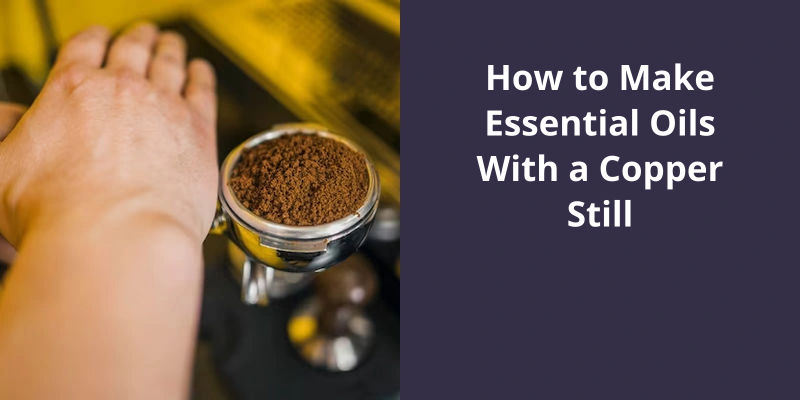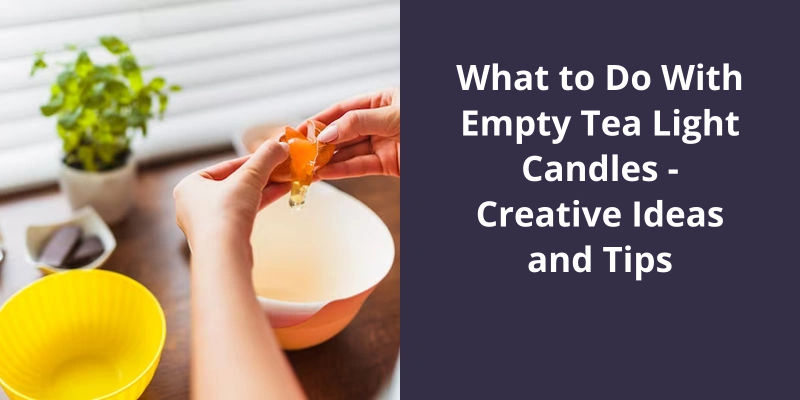Making essential oils with a copper still starts with chopping your plant material into small pieces and filling your copper still about halfway. Then you’ll need to add water until it covers the chopped plants, yet make sure not to overfill the still. From there, you light a heat source under your copper still to boil the water, which turns it into steam. This steam essentially carries the oil from the plants upward into the onion of the still, also known as the ‘column.’ The steam, which now also carries oils, travels down into the condenser coil where it cools down and transforms back into a liquid form. This works because oil from the plants doesn’t mix with water and instead splits off, floating to the top due to its lower density. Finally, this oil that floats on top is your essential oil, which you can skim off and store in a separate container.

Can You Make Essential Oils With a Copper Still?
#2: Choose your plant material. Before you start distilling, it’s important to choose the right plant material. Youll want to use fresh, high-quality plants to get the best results. Do some research on the plant you plan to use and make sure it’s safe for distilling. Once youve chosen your plant material, chop it up and put it in the still.
#3: Add water. Fill the still with water to just below the level of the plant material. The water and steam will help extract the essential oils from the plant material. It’s important not to overfill the still, as this can cause the water to boil over and mix with the essential oils, diluting their potency.
#4: Distill the oils. Once everything is set up, heat the still over a low flame. As the water heats up, steam will start to rise and carry the essential oil out of the plant material and into the condenser. As the steam cools and condenses in the copper coils, the essential oil separates from the water and collects in a separate container.
#5: Store your essential oils. Once youve collected your essential oils, it’s important to store them properly to maintain their potency and fragrance. Store them in a cool, dark place – such as a cupboard or drawer – and away from direct sunlight. Essential oils should also be stored in dark glass bottles to prevent exposure to light and heat.
#6: Clean your still. After using your copper still to make essential oils, it’s important to clean it thoroughly to prevent any residue from building up. Copper is naturally antimicrobial, but it’s still important to sterilize your still before and after each use. Fill the still with water and heat it to boiling, then add a small amount of vinegar or lemon juice to help break down any residue. Rinse the still thoroughly and dry it before storing. By following these steps, you can use a copper still to make your own high-quality essential oils at home.
Benefits of Using a Copper Still for Essential Oil Distillation Compared to Other Materials
Copper stills are often preferred for essential oil distillation over other materials due to their ability to conduct heat efficiently, maintain consistent temperature, and resist corrosion. Furthermore, copper can ionize the essential oils, improving their aroma and therapeutic properties.
However, using an alcohol distiller for essential oils requires some modifications to the equipment and process.
Can Alcohol Distiller Be Used for Essential Oils?
However, it’s essential to note that not all alcohol distillers are suitable for essential oil extraction. The type of still that you should use depends on the type of essential oil that you’re trying to extract and the method that you’re using.
For steam distillation, youll need a still that allows steam to pass through the plant material to extract the oils. This requires a still with a separate botanical chamber, which is often the case with many essential oil distillers.
Some essential oils are flammable, and alcohol distillers use heat, which can cause fires if improperly handled.
With proper care and attention to detail, you can create high-quality essential oils that can be used for a variety of purposes, from aromatherapy to natural cleaning products.
While it’s possible to use an alcohol distiller for essential oils, it’s important to select the appropriate still for the job, whether that be a steam distillation still or a cold press still. Additionally, care must be taken to ensure that high-quality materials are used and that safety protocols are followed.
The Difference Between Steam Distillation and Cold Press Extraction Methods for Essential Oils
Steam distillation and cold press extraction are two common methods of extracting essential oils. Steam distillation involves boiling plant materials and passing the resulting steam through a condenser to produce essential oils, while cold press extraction involves mechanically pressing plant materials to release oils. The main difference is that steam distillation can extract oils from a wider range of plant materials, while cold press extraction is typically used for citrus fruits and other plants with high oil content in their peels or seeds.
Source: Distill Essential Oils With a Moonshine Still
This method allows for the plant’s essential oils to be extracted and collected in the water. The result is a pure, concentrated essential oil that can be used for a variety of purposes. Keep reading to find out more about this process and how you can make your own essential oils at home.
What Is the Easiest Way to Make Essential Oils?
The vapour then turns into liquid, which is essentially the essential oil. This method is straightforward and can be done even with basic equipment that you might already have in your kitchen.
Another method that you can use to make essential oils is by cold pressing. This is typically used for citrus fruits like lemons and oranges. With cold pressing, you extract the essential oil by grinding or juicing the fruit and then letting the oil separate from the pulp. This method is also relatively easy to do, and you don’t need any fancy equipment.
If you prefer a more hands-off approach, you can use a still to make essential oils. A still is a specialized piece of equipment that can be used to extract essential oils from various plant materials. While not as easy as the other methods, it’s still relatively simple to use and can give you a higher quality oil.
For those who want an even easier way to make essential oils, there are kits available that provide everything you need to get started. These kits typically come with a distillation apparatus, plant material, and instructions on how to use it. This is a great option for beginners who’re unsure where to start.
No matter which method you choose, it’s important to use high-quality plant materials. This will ensure that you get a high-quality essential oil. If you don’t have access to fresh plants, you can also purchase dried herbs and flowers from reputable suppliers. It’s also important to use caution when working with hot materials, and to follow all safety guidelines.
Making essential oils doesn’t have to be difficult or intimidating. With the right equipment and materials, it’s a simple process that you can do from the comfort of your own home. So why not give it a try and see how easy it can be to make your own essential oils today?
Common Plants Used for Making Essential Oils
Essential oils are oils extracted from plants that are used in various products like perfumes, soaps, cosmetics, and aromatherapy. Some of the commonly used plants for making essential oils are lavender, peppermint, lemon, eucalyptus, tea tree, chamomile, ylang-ylang, and rosemary. These plants are known for their aroma and therapeutic properties and are carefully cultivated to ensure the quality of the essential oil extracted from them.
Making essential oils from a still can be a fun and rewarding process that allows you to create your own custom blends right at home. However, it’s important to follow a few simple steps in order to ensure that you get the most out of your plants and produce high-quality oils. Keep reading to learn more about the process and how you can get started today.
How Do You Make Essential Oils From a Still?
Essential oils are concentrated plant extracts that are widely used in aromatherapy, cosmetics, and herbal medicine. They’re extracted from various parts of plants, including leaves, flowers, roots, and bark. One of the most common methods of extracting essential oils is through the use of a still.
To make essential oils from a still, the first step is to harvest the raw plant material. This can be done at different times depending on the plant and the part of the plant used. For example, lavender flowers should be harvested in the morning when the oil content is highest. The plant material should be fresh and harvested at the right time to ensure the best quality oil.
After harvesting, the plant material can be dried (optional) to remove any excess moisture. This can be done by hanging the material in a cool and dry place away from direct sunlight. Once the plant material is dry, it’s ready to be used in the still.
To extract the essential oils, water is added to the still along with the plant material. The still is then heated to a specific temperature to vaporize the oil. The oil vapor is then condensed back into a liquid form and collected.
After collecting the oil, it’s important to filter it to remove any impurities or debris. This can be done using a filter paper or cloth. Once filtered, the oil can be poured into a container for storage. It’s important to store essential oils in a cool and dark place to protect them from light and heat.
Lastly, it’s important to clean the still after each use. This can be done by using a mixture of water and vinegar to remove any remaining plant material or residue. Cleaning the still ensures that the next batch of oil isn’t contaminated.
Overall, making essential oils from a still can be a time-consuming process, but it’s a rewarding and fragrant way to create natural remedies, perfumes, and other aromatic products. By following these steps, you can make essential oils that are high in quality and purity.
Examples of Plants Commonly Used for Essential Oil Extraction
Plants that are commonly used for essential oil extraction include lavender, peppermint, eucalyptus, tea tree, citrus (such as lemon and orange), and rosemary. Essential oils are extracted from these plants using various methods, including steam distillation, cold pressing, and solvent extraction.
Now that we understand the basic steps of essential oil distillation, let’s take a closer look at how lavender oil can be made from a still. By following these steps carefully, you can extract high-quality lavender oil that can be used for a variety of purposes, from aromatherapy to cooking.
How Do You Make Lavender Oil From a Still?
Lavender oil is a popular essential oil that’s well known for it’s natural fragrance and soothing properties. It’s made by distilling the flowers of the lavender plant using a still. The distillation process involves heating the plant material to release the essential oil which is then collected in a condenser tube, cooled, and collected as a liquid. Here are the basic steps for making lavender oil from a still:
First, choose high-quality lavender flowers for distillation. It’s important to use fresh, organic, and pesticide-free flowers to ensure the purity of the oil. The lavender flowers should be carefully harvested and immediately placed in the still.
Next, add water to the still and place it on a heat source. The water should be boiled until it produces steam that rises through the lavender flowers. As the steam passes through the plant material, it extracts the essential oil and carries it into the condenser tube.
The condenser tube is a coiled pipe that’s cooled by cold water. When the steam rises up the condenser tube, the cold water cools it down and turns it back into a liquid. The essential oil and water (now hydrosol) are collected separately at the end of the condenser tube.
The essential oil will be floating on top of the hydrosol and can be easily separated using a pipette or a separating funnel. The hydrosol can also be used as a natural toner or facial mist.
Once the oil has been collected, it should be filtered through a cheesecloth to remove any remaining plant material and impurities. The oil can then be stored in a dark glass bottle, away from heat and direct sunlight.
The resulting oil can be used for aromatherapy, massage, and beauty applications.
Tips for Choosing the Right Still for Lavender Oil Distillation.
Choosing the right still for lavender oil distillation involves considering factors such as the size of the still, the material it’s made of, and the type of heat source. It’s important to select a still that allows for efficient and effective distillation of the lavender plant to produce high-quality essential oil.
Conclusion
The process of steam distillation allows the essential oils to be extracted from the plant material in a gentle and natural way, preserving the aromatic and therapeutic properties of the plant. With careful attention to the temperature and timing of the distillation, high-quality essential oils can be produced with the unique nuances and characteristics of the specific plant being distilled.





